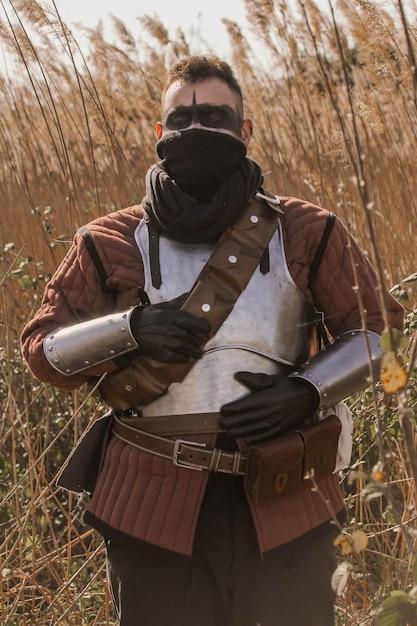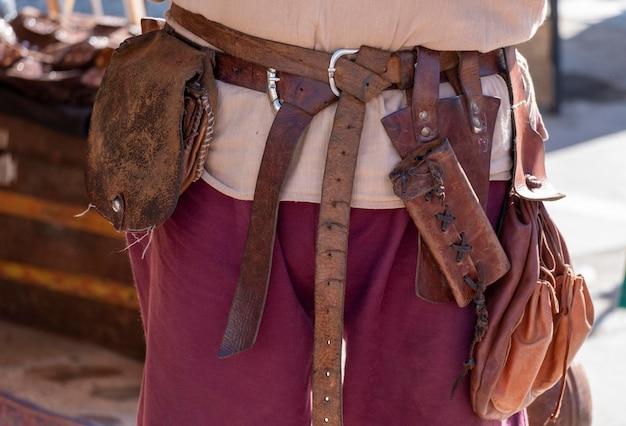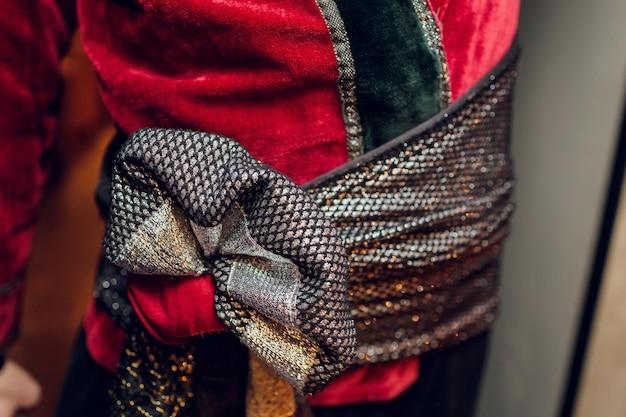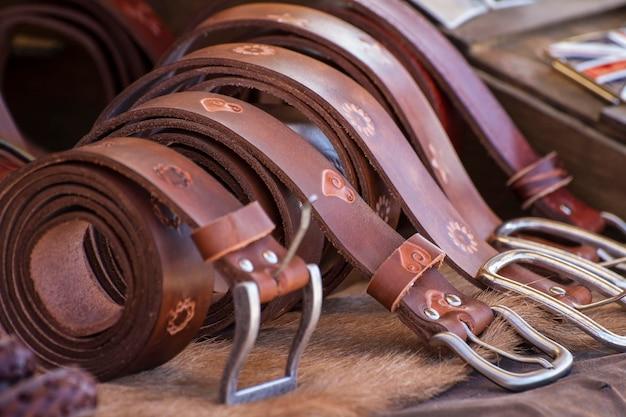Belts have always been a fashion item, and they date back to the medieval period. The medieval belt was not only a fashion accessory but also served a functional purpose. It helped to hold clothing together and allowed people to carry essential items with them. Today, the medieval belt is still popular among fashion enthusiasts and is available in various designs and styles. In this blog post, we will explore the different types of medieval belts, such as the renaissance belt and leather ring belt, and discuss their usage. We will also delve into medieval belt pouches and other accessories and answer questions such as “What is a medieval belt called?” and “Did they have belts in medieval times?” So, let’s dive in and explore this fascinating world of medieval fashion!
The History of the Medieval Belt
Belts have been a part of human clothing since ancient Egypt. However, medieval belts had a special place in fashion history. They were not just simple accessories to keep one’s pants up. Medieval belts were an essential part of a knight’s armor and were used to hold their weapons in place during battles. Let’s dive into the history of the medieval belt and discover the reasons why they were so important back then.
The Noble Title Belt
During the medieval era, only nobles and the upper class were allowed to wear fancy belts. The belt itself was made from high-quality materials like leather or fabric. It would often have striking designs like heraldic badges or family crests engraved on them. The belt was a symbol of high status in medieval society, and it was worn to show off the wearer’s wealth and influence.
Knight’s Battle Belt
In addition to being a fashion accessory, medieval belts were also an essential part of the knight’s armor. The knight’s battle belt was designed to hold their swords, daggers, and shields in place. The belt was made of sturdy leather and featured metal studs or buckles for added strength. The belt allowed the knight to move more freely and have quick access to their weapons during battles.
Women’s Belts
Medieval women also used belts, but they had a different function. Women’s belts were worn to accentuate their figure and to keep their dress in place. Their belts were often more decorative than functional, featuring beautiful intricate designs. Women’s belts were made from the finest fabrics like silk or velvet and decorated with jewels, pearls, and gold.
Belt Etiquette
Belts were an important part of Medieval etiquette. The way you wore your belt could say a lot about your status and personality. For example, wearing your belt loosely was a sign of relaxation, while a tight belt showed dignity and formality. The position of the belt buckle could also indicate political or religious affiliation.
In conclusion, the medieval belt was more than just a way to keep one’s pants up. It was a fashion accessory, a symbol of status, and an essential part of a knight’s armor. Today, the belt is still a significant accessory in fashion, and it has evolved to serve different functions. But it’s worth remembering the rich history behind the humble belt we wear today.
Renaissance Belt
Now, let’s move forward a couple of centuries, shall we? The medieval age is fascinating, but the Renaissance is where it’s at! And what better way to put that in practice than by updating your medieval belt to a Renaissance belt?
Fashionable Yet Functional
During the Renaissance, fashion was taken to a whole new level. The clothing was not only practical and comfy but also visually pleasing and stylish. And, as you may have guessed, the belt became a central aspect of any outfit.
A Renaissance belt is a game-changer when it comes to fashion, and it’s not just because it looks good. These belts are also incredibly functional and versatile. They were perfect for holding weapons, pouches, and pretty much anything one might need in their day-to-day life.
Leather All the Way
Leather was the preferred material for Renaissance belts. And who can blame them? Leather is durable, malleable, and overall a great material for making belts. The quality of the leather was also top-notch, often handcrafted with intricate details.
Buckle Up!
The buckle was another aspect that changed during the Renaissance. Belts became more of a fashion statement, which meant that buckles became more elaborate and decorative. The Renaissance belt buckle was the perfect canvas for artisans and craftsmen to show off their skills.
Your Renaissance Belt: A Perfect Accessory
In conclusion, a Renaissance belt is a fashion statement you can’t afford to miss. It’s a perfect accessory that not only looks great but is also functional. And, let’s face it, a belt is a crucial aspect of any outfit. A Renaissance belt can take your look to a whole new level. Trust me; you won’t regret investing in one.
Leather Ring Belt: The Perfect Accessory for a Medieval Look
If you want to elevate your medieval ensemble to the next level, then you simply cannot overlook the importance of a good leather ring belt. Not only does it have a practical and functional use of keeping your pants up, but it also lends a certain air of authenticity and ruggedness to your outfit.
The History of the Leather Ring Belt
Believe it or not, the leather ring belt has a long and storied history. Dating back to the medieval times, it was originally used as a practical way to tether weapons and other essential items to one’s person. As time went on, it became more of a fashion statement, with various embellishments and designs adorning the belts.
Why Choose a Leather Ring Belt Over Other Options
There are a lot of different belt options out there, so why stick with a leather ring belt specifically? For starters, it’s a classic look that never goes out of style. It’s also versatile enough to pair with a variety of different outfits and styles. Plus, the ring design allows for more adjustability and a secure fit.
How to Choose the Right Leather Ring Belt
When it comes to choosing the perfect leather ring belt, there are a few things to keep in mind. First and foremost, you want to make sure it fits properly. Too loose and it won’t serve its functional purpose, too tight and it’ll be uncomfortable to wear. You also want to pay attention to the quality of the leather and the overall construction of the belt.
Styling Tips for Your Leather Ring Belt
So you’ve got your leather ring belt, now what? One great way to style it is by pairing it with a tunic or long shirt. This allows the belt to really stand out and adds an extra layer of interest to your outfit. You can also experiment with different colors and textures of leather to really make a statement.
In conclusion, a leather ring belt is a must-have accessory for anyone looking to embrace the medieval look. Not only is it functional, but it adds a certain level of authenticity and ruggedness to your outfit. With so many different options out there, you’re sure to find the perfect belt to fit your style and needs.
Medieval Belt Pouch: Carrying Your Belongings in Style
Do you ever get tired of carrying around a bulky bag or trying to stuff all your items into your pocket? Fear not, my fellow medieval enthusiasts, because the solution is here: the medieval belt pouch.
What is a Medieval Belt Pouch
As the name suggests, a medieval belt pouch is a small bag or pouch that can be attached to your belt for easy access to your belongings. They were commonly used in the Middle Ages as people would often travel long distances and needed to keep their essentials such as coins, keys, and other small items close at hand.
Styles of Medieval Belt Pouches
Medieval belt pouches come in all shapes and sizes. Some are made from leather and have decorative stitching or designs, while others may be made from fabric or jute. The most common styles have a flap closure with a buckle or drawstring to keep your items secure. You can choose to have a plain pouch, or one adorned with studs, jewels, or other embellishments.
How to Wear a Medieval Belt Pouch
To wear a medieval belt pouch, simply attach it to your belt using the loops or straps on the back of the pouch. It’s recommended to wear the pouch on your hip rather than your back to avoid it bumping into you as you walk.
DIY Medieval Belt Pouch
Feeling crafty? You can easily make your own medieval belt pouch using a piece of leather or fabric and some basic sewing skills. There are plenty of tutorials online to help you get started.
The medieval belt pouch is not only functional but also adds a touch of authenticity to your medieval ensemble. So, whether you’re heading to a renaissance fair or just want to add a bit of flair to your everyday look, the medieval belt pouch is the way to go.
Medieval Accessories: More Than Just Belts
When it comes to medieval fashion, belts aren’t the only accessories that were in vogue. In fact, there were plenty of other accessories that made up a medieval outfit. Here are some of the other essential accessories that any knight or lady would have never left their castles without.
Buckle Up
One of the most important medieval accessories was, of course, the buckle. Belts without buckles were simply strips of leather; without them, the belt wouldn’t stay on the waist. Buckles were made of various materials, such as brass, iron, or silver. They varied in shape and design, from simple rectangles to intricately designed ovals or circles.
Hats Off
Another accessory that was necessary in a medieval outfit was the hat. They served both practical and decorative purposes. Peasants and laborers wore hats to protect themselves from the sun, while knights and lords wore hats to display their status and complete their attire.
Shielding The Hands
Gloves were another essential medieval accessory. They provided protection for hands while also adding to the overall aesthetic of the outfit. Gloves varied from plain to embroidered and were made from different kinds of materials.
Bling It Up
Jewelry played a significant role in medieval fashion and was used as a status symbol. It was not uncommon to see nobles adorned with gold, silver, and precious stones. While regular folks couldn’t quite afford such luxuries, they still managed to wear jewelry made of cheaper metals.
To Pouch Or Not To Pouch
Pouches were another accessory that both men and women wore to carry small personal objects. They were mainly made of leather or fabric and varied in shape and size.
Footwear That Made A Statement
Last but not least is medieval footwear, which was not just for covering one’s feet. They were often made of leather and had a unique style. Knights wore taller boots, while women wore shoes that resembled slippers.
Medieval accessories like hats, gloves, and expensive jewelry were crucial in making a fashion statement and displaying one’s status. However, practical accessories like buckles, pouches, and gloves were necessary for daily use. Medieval fashion was more than just belts, and exploring the world of medieval fashion accessories reveals just how exciting it can be!
What’s in a Name? Decoding the Medieval Belt
When we think of medieval belts, we often imagine thick leather belts with ornate buckles, worn by knights and lords ready for battle. But what exactly would you call such a belt? Is there a specific name for it? Well, the answer, like most things in medieval history, isn’t so straightforward.
The Many Names of the Medieval Belt
The medieval period spans over 1,000 years and covers a vast geographical area, so naturally, the belts worn during this time came in many shapes and sizes with varying degrees of ornamentation. Depending on the region and time period, belts could be known by different names, including:
The Girdle
The girdle was a common term for a belt worn by both men and women in the medieval period. It was typically made of fabric or leather, and could feature decorative metalwork. Medieval women wore girdles to cinch their waists and give the appearance of a smaller figure. Men would wear thicker girdles as a practical accessory for carrying weapons.
The Belt
The belt is a catch-all term for any type of waistband worn during the medieval period. It could be as simple as a strip of leather or cloth tied around the waist, or as intricate as a wide belt with elaborate metalwork. The term “belt” is still in use today to describe any type of waistband.
The Military Belt
Knights and soldiers often wore metal belts as part of their armor. These belts were called military belts or sword belts since they held weapons and were fashioned with metal hooks or clasps for quick attachment and detachment.
The Baldric
A baldric is a belt that is worn over one shoulder and diagonally across the chest, used for carrying a sword or other types of weapons. Baldrics were typically made of leather and were often adorned with ornate metalwork.
As we can see, there were several names for medieval belts depending on the time period and region. Some belts were made to be functional, while others were used for decorative purposes. No matter what they were called, it’s clear that belts were an essential accessory during the medieval period. So, whether you’re going to a Renaissance fair or just want to add a bit of medieval flair to your outfit, now you know what to call your belt!
Did people wear belts in medieval times
Belts have served many purposes throughout human history, from holding up pants to being a status symbol. But did medieval folks wear belts? Let’s dive into this sartorial mystery!
Belts: A Brief History
Belts are believed to have originated around the Bronze Age and have been in use ever since. In medieval times, they were primarily functional, used to hold up trousers or tunics and provide support for weapons. However, belts also held more symbolic significance, such as being an emblem of knighthood or a sign of wealth and status.
What Were Belts Made Of
Belts in medieval Europe were made from a variety of materials, including leather, fabric, metal, and even beads. The quality of the belt material often indicated the wearer’s social status. For example, a lord might wear a leather belt decorated with gold detailing, while a peasant would wear a simple woven belt made of fabric.
Belt Buckles
Belt buckles were also an important feature of medieval belts. Buckles were often made of metal and were highly decorative. Like the belts themselves, the quality and intricacy of the buckle design indicated the wearer’s social status.
Why Did They Wear Belts
Aside from providing functional support for clothing and weapons, belts were also an important part of medieval fashion. Belts often matched other pieces of clothing or accessories and were used to tie an outfit together. Additionally, belts were often used to display insignia or symbols, offering a visual representation of the wearer’s identity.
Wrapping Up
So, did people in medieval times wear belts? Absolutely! Whether it was for practical purposes or as a status symbol, belts were an essential part of medieval fashion. Plus, who doesn’t love a good accessory?



